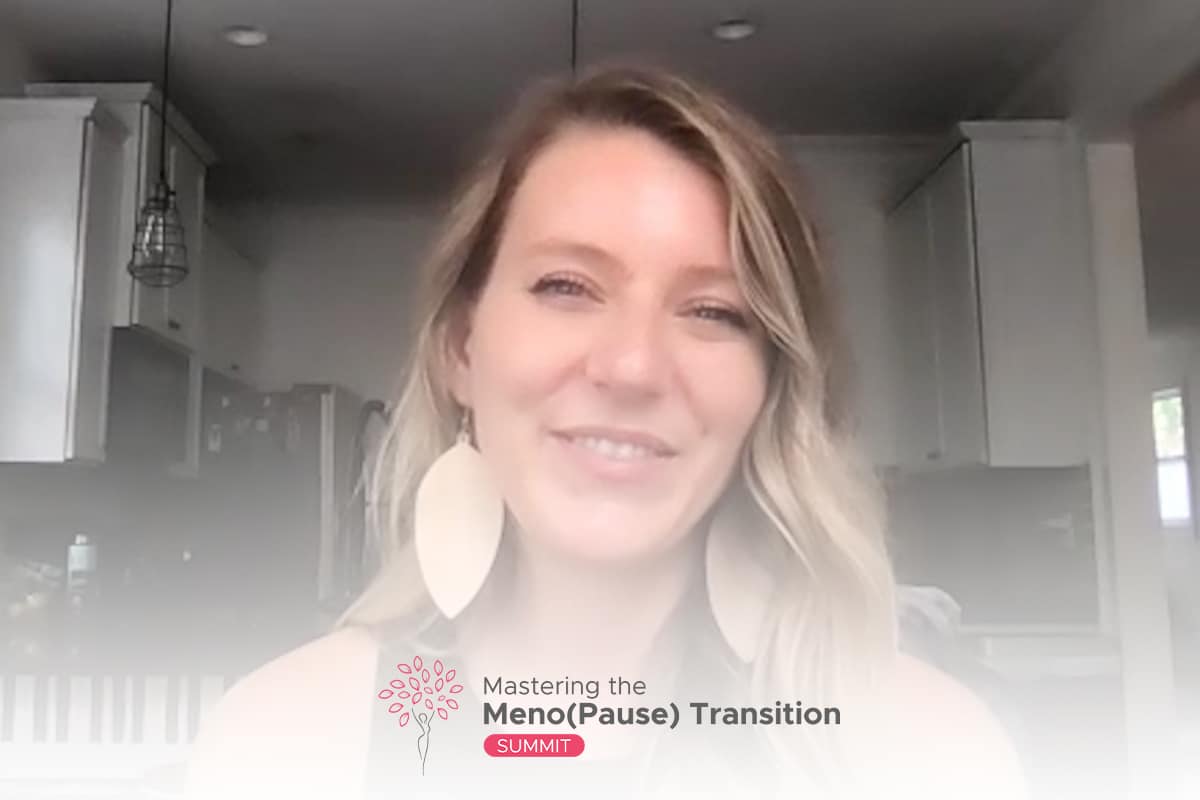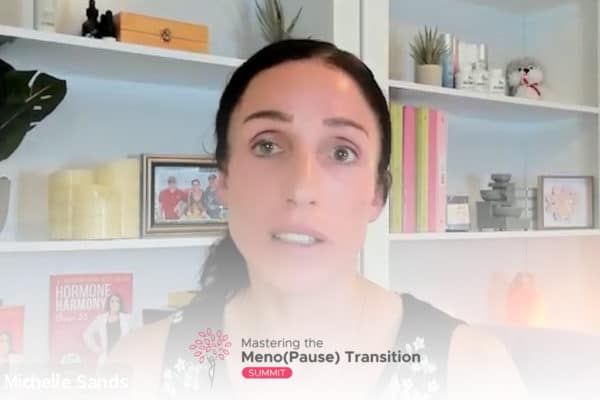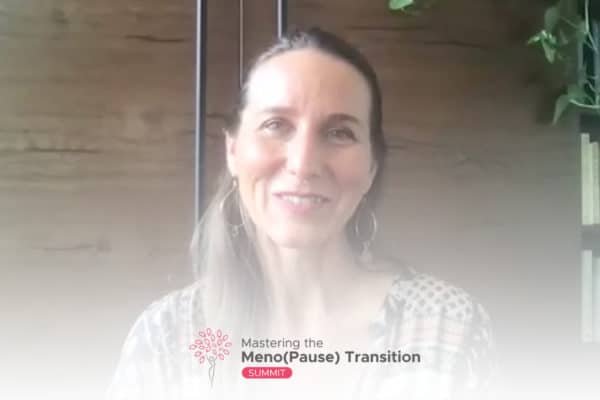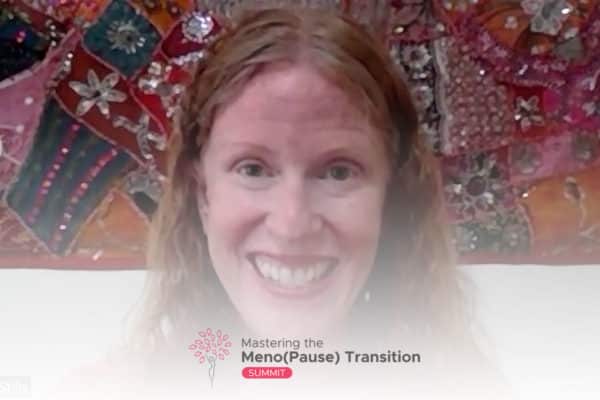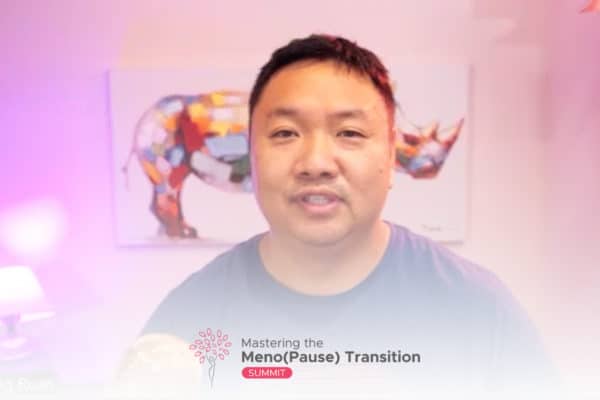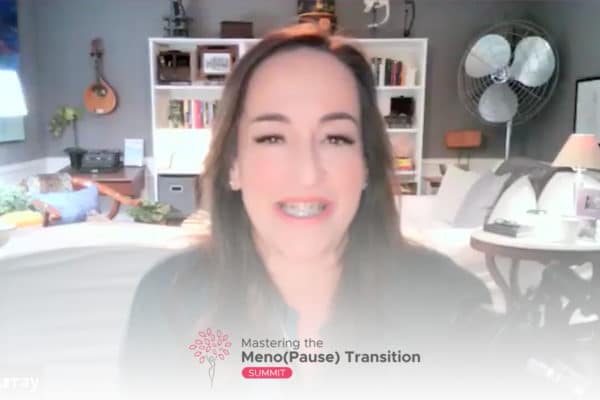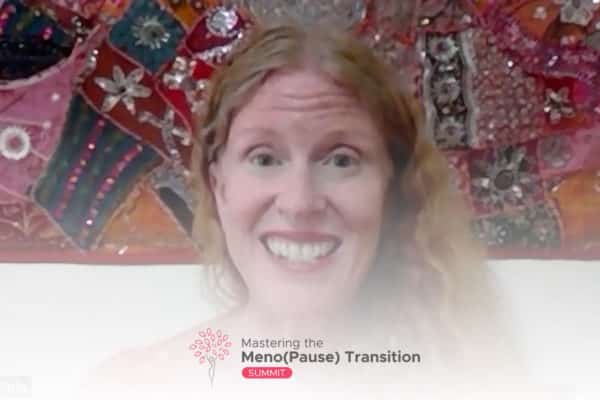Join the discussion below
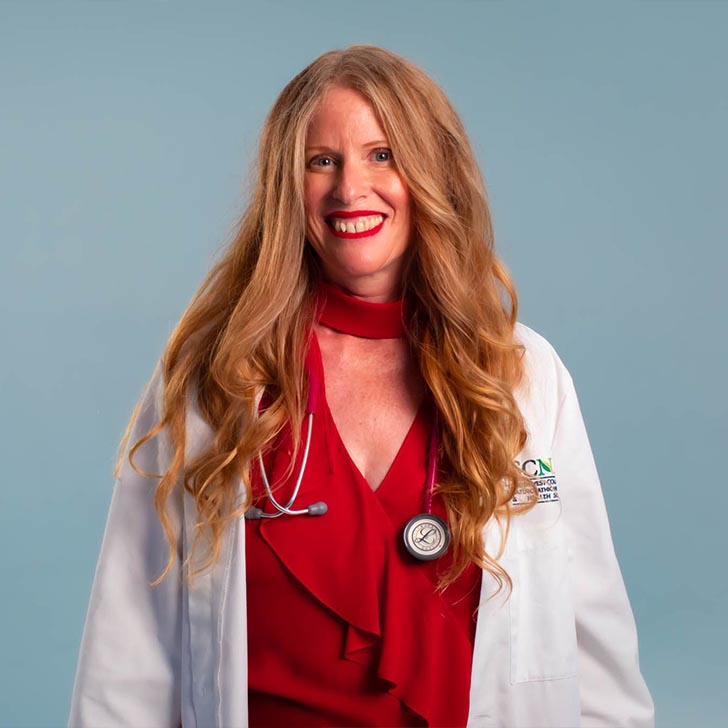
Dr. Sharon Stills, a licensed Naturopathic Medical Doctor with over two decades of dedicated service in transforming women’s health has been a guiding light for perimenopausal and menopausal women, empowering them to reinvent, explore, and rediscover their vitality and zest for life. Her pioneering RED Hot Sexy Meno(pause) Program encapsulates... Read More
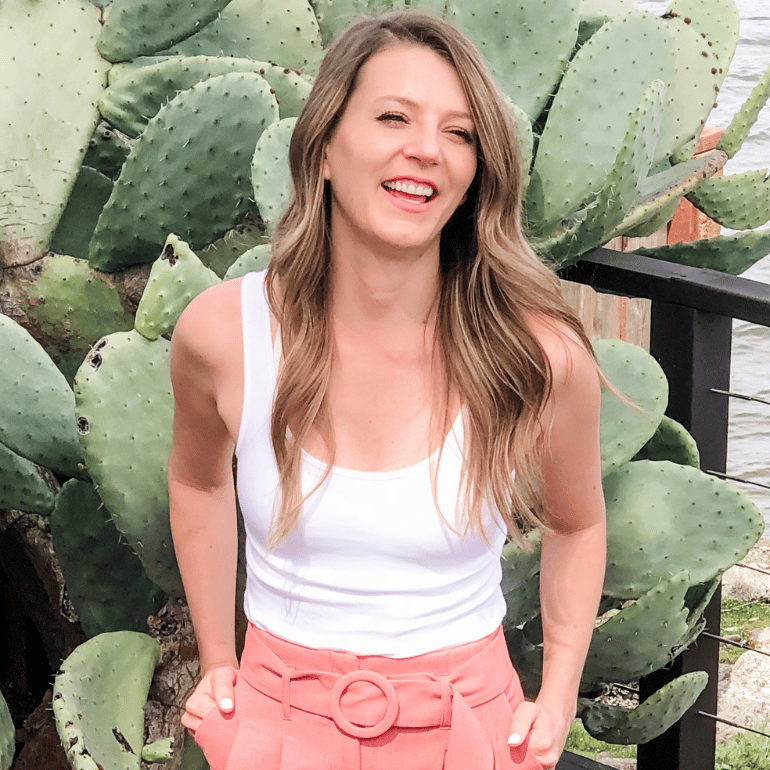
Kayla is a neuropsychophysiologist and award-winning women's health expert whose work has been featured on stages and media around the world. Her pioneering work in women's health science led to discoveries that are changing the landscape of feminine health as we know it. She is here today to share her... Read More
- Women represent the largest gap in health science research, which has led to a gross misunderstanding of female health and biology
- The missing link in women’s health that will revolutionize the way you see and support women
- How the female brain is wired for leadership
Related Topics
Adrenals, Cholesterol, Clinical Research, Female Biology, Hormones, Menopause, Research Studies, Womens HealthDr. Sharon Stills
Hi ladies, welcome back to Mastering the Menopause Transition Summit. I’m your host, Dr. Sharon Stills. Lovely to see you here. And we’ve got a great conversation with something that’s gonna really hit home for you, being a mostly women audience. So if you’re a man watching, that’s okay too. You can learn more about the women in your life, but we’re gonna be talking today with Kayla Osterhoff. Did I get that right?
Kayla Osterhoff
Yes, that’s right.
Dr. Sharon Stills
Who is a neuropsychophysiologist and an award-winning women’s health expert whose work has been featured on stages and media around the world. Her pioneering work in women’s health science led to discoveries that are changing the landscape of feminine health as we know it. She’s here today to share her discoveries and reveal the missing link in women’s health. So, Woohoo. I’m excited to have you here.
Kayla Osterhoff
Me too. Thank you so much for having me here. I’m really excited to talk all things, the magic of feminine biology.
Dr. Sharon Stills
So neuropsychophysiologist, that’s a mouthful. So I’m just curious, how did you end up pursuing a PhD in that field?
Kayla Osterhoff
Yeah, I really have always been interested in the human body and especially the human behavior. And actually when I was little, my mom always used to joke and tell me I’m gonna be a brain surgeon. And I feel like that had some kind of psychological impact because here I am now studying the brain, the mind and the interaction between those two systems. So of course I’m not cutting open the brain, but I do look at, you know, the electrical activity and the chemical activity of the brain. So it’s a similar idea. And so growing up, I’ve always been really fascinated by why people do the things that they do and why some people end up sick and unhappy and why some people are really happy and healthy in their life. And unfortunately in my family, almost all of the people in my family suffer from some kind of mental illness.
And specifically the women within my family have really suffered and really struggled with their mental and physical health. And so as I watched that growing up, I was always curious about it. And in undergrad, I was actually studying to go into physical therapy school, but quickly shifted gears towards the end of my undergrad into public health which is what I got my master’s in because my mom, during that time ended up with a overdose from opioids. And this was kind of a shock to our entire family and really turned my life upside down personally. And I was so angry at the health systems that actually caused this addiction. Her addiction was a 100% fueled only by her doctors and she was taking the medicines as prescribed. And she was a full blown opioid addict and almost lost her life because of it.
So that’s when I shifted gears to public health and my goal was to go and work at CDC on the opioid epidemic. And when I graduated with my master’s in public health, I did get the job at CDC though I didn’t end up working in opioids. I ended up working in emergency response and global health and traveling all over the world and getting to do all kinds of cool research and projects with them. And it really deepened into my fascination about human behavior even more as I got to see these other cultures and I got to see how people’s health is impacted by their environments and how there are different health disparities in different regions where there are different levels of resources. And this all kind of fueled my passion in understanding human behavior and especially understanding the human brain and psychology. And so when I decided to go back and get my PhD, I wanted that terminal degree to be in what I love the most, which is really researching the human brain and the human mind. And the program that I found was neuropsychophysiology which was perfect because that is the study of the brain, the mind and the body, the physiology, and how they’re all wired together and how all three of those systems work together to create human behavior or the human experience.
Dr. Sharon Stills
You’re making me wanna go get a PhD. I’m like, this is so cool.
Kayla Osterhoff
Yeah, oh my gosh. I love my program. If you’re interested, I could send you all the info.
Dr. Sharon Stills
I dunno if I have time for that, but I’m like, oh my God, I love everything. I could just tell you like, oh, you’re doing such great things. That’s fantastic. So let’s dive in. One of the things you talk about is this gender gap in health research and how this has negative implications for women. And so we’ve got a lot of women here. So what do we need to know about that and how did that happen?
Kayla Osterhoff
Yeah, well, this all started for me in terms of finding out that this was even the case was my own health started to deteriorate when it was about seven years ago, I think now six or seven years ago. And at the time I was working at CDC traveling all around the world. I was starting up my PhD process. And I was also at the time, I was performing as an athlete for team USA in Duathlon. And all of that was going on at the same time. And I was doing all of the things I was taught to do for my health to be healthy, right? ‘Cause I had studied the health sciences my whole life. I knew how to take care of my health. I knew the bio and the chemistries and the neurologies and all of those things, right?
But apparently I didn’t know because my adrenals started to crash and then my hormones followed thereafter and eventually my hormones completely flatlined. And my doctor said I basically have the hormones of a 90-year old woman. And that was pretty scary in a pretty big wake up call. So as I got into my studies in neuropsychophysiology, I focused everything towards women, which was hard to do because what I found was that there’s a huge hole in our research. That women are actually not included in the clinical research. And so the data on female bodies, female biology is just not there. So it made it really hard to actually focus on women in my studies. And then reflecting back in my educational process, I realized that nowhere along the way, and this is the same for you and other medical doctors and nurses and coaches and other health professionals that we never once get one course on feminine biology and how it’s different from male biology. You know, there’s women’s studies and this is more about cultural and behavioral type of things that go on.
And then there’s also, you know, the bikini medicine which is studying the parts that are covered up by bikini, right? The breasts and the ovarian processes, the reproductive parts, but the big missing gap in the research is the rest of the female biology which is not the same and doesn’t operate the same as our male counterparts. So that’s, you know, what I ended up diving into and really focusing my research on over the past six years, and what I found is just that. Is that there are significant differences between men and women and the way our biology operates that is being completely ignored by our scientific medical and educational communities.
Dr. Sharon Stills
So when you say that women aren’t involved in research, so let’s just take like a cholesterol research study. Are you saying they only put men in the studies?
Kayla Osterhoff
Yes, so actually dating back to 1977, the FDA formally banned all women of child bearing potential from all clinical research. That remained in effect till 1993 when it was overturned. Since 1993 women are still left out of the clinical research. And when they are included, it is not at the appropriate levels, right? So sometimes women are included who are postmenopausal because the assumption is that we’re more like men postmenopause which is absolutely not even close to being the case. So even those studies are skewed in under a false assumption. But yes, even to this day, women are left out of the clinical research and sparsely included.
And even when women are included in the research, the findings are not presented by gender, which they have to be, right? They have to be presented by gender. And the reason why is because there’s not enough women compared to men for them to parse it out. So the reason why this is the case is actually, it’s a logical reason why women have been left out, although it doesn’t make it right. And that is that women are risky research subjects while they’re cycling, right? Because they can become pregnant during the study. And the other more fascinating reason, which is actually the reason why women are misunderstood is that we have this biological complexity. So women are physiologically shifting all the time, meaning that they’re very difficult research subjects ’cause they’re changing all the time. And so it’s really, really hard to control for that. And so instead of figuring out ways to do that, the solution is just leave them out. It’s too hard.
Dr. Sharon Stills
Wow. You’re kind of just like mind blown ’cause, I mean, and me personally as a physician, I depend more on the research of the ancient Vedics and the traditional Chinese medicine and just intuition and things of that nature. But it’s just like, wow, it’s not really well known that that’s the case. You kind of just assume things and we know what happens when you assume. So you mentioned something that women’s biology is very different than men’s. And obviously we know that women cycle, we know that women can get pregnant, but are there some other examples you could share with us that are not so obvious?
Kayla Osterhoff
Yeah. So the significant differences all revolve around what I call the bio rhythm. So the male and the female bio rhythm. And what I mean by that is the operating system for our biology or kind of the biological clock that our physiological systems operate under. So our male counterparts, their bio rhythm is set to the pace of the adrenal hormones or our sleep wake cycle, right? Cortisol and melatonin, which is a daily repeating 24-hour system. And when you look at the male physiology at large, so the cardiovascular system, the respiratory system, the nervous system, the metabolic system, the immune system, the neuroendocrine system, all of those things operate on a 24-hour repeating clock. So every day biologically speaking, men are pretty consistently the same with long term, really slow changes over their life phases.
But day to day, pretty much the same. It kind of repeats on a 24-hour cycle. Now our ladies are much more complicated of course, the reason why we’re left out of the research. And that’s because our biological clock, our biological rhythm is set to the pace of the ovarian hormones. And that is this 28-day long cycle that’s an ebb and flow of estrogen and progesterone. So what that means is that’s why we are shifting little by little every single day as women and most significantly, we shift four times over the course of a month as these major shifts in those hormones modulate our global physiology. So all of those systems that I talked about before are actually modulated and
impacted significantly by the ebb and flow of the ovarian hormones during our premenopausal phase of life. And then we’ll talk about, of course what happens postmenopausal as well.
Dr. Sharon Stills
So many questions already. Okay. So you’re saying for a woman, let’s just start with the cycling woman and I know that doesn’t apply to most of you, but we gotta kind of go there so we can learn about where you’re at in your journey now. And so you’re saying the 28-day cycle and a female affects her lungs, her gut, her heart, affects everything.
Kayla Osterhoff
Everything, literally everything. Kind of a cool fact that my fellow neuro nerds will enjoy is that recently, and I mean, like within the last five years, we found out that the female brain actually has high densities of receptors for estrogen and progesterone in certain areas of the brain. And most specifically, the prefrontal cortex, the hippocampus and the hypothalamus have the highest densities of these receptors. And these areas of the brain are involved in decision making, memory consolidation, emotional intelligence, verbal and mental acuity, things like that. And so those cognitive abilities and the way that our brain functions electrically, chemically actually shifts over the course of the month through these phases as those two key hormones which end up actually being neurotransmitters as well, modulate our brain function.
And that’s what happens in our physiology at large. And so it’s like this repeating cycle that doesn’t happen every day like our male counterparts, but happens over the course of a month. And that’s why us beautiful ladies are very difficult research subjects, but it’s also why sometimes we feel that we have higher levels of energy throughout the month. And sometimes we feel that we have higher levels of mental acuity throughout the month. And sometimes we feel like we have better power, strength and endurance. And sometimes we feel like we metabolize things faster or better, right? Because all of that is true. That is what’s literally happening in our bodies. And so the key is to really understand how all of that shifts over the course of the month through the different phases so that we can operate in a way that’s actually in partnership with our body instead of kind of swimming up river and utilizing all of our resources too quickly.
Dr. Sharon Stills
Exactly. It’s I always think of the red tent and when you’re bleeding, you know, in the native, they would go to the tent and commune with each other and take a break and that’s because the hormones and where they’re at. And so it’s really important that we connect and work with. Otherwise you’re like a fish swimming upstream and you’re making it more difficult. So for the women who are here who, hooray, are pre-gaming and wanna learn what they can be doing as they go through this beautiful menopause transition. So, and they’re more in a perimenopausal state where, can be the perimenopausal rollercoaster of where our hormones. What would you have to say for them and how.
Kayla Osterhoff
Yeah, so what’s really interesting and unfortunately we only have anecdotal evidence, but we do have evidence from thousands of cases of women. We don’t have empirical evidence because of the science problems that I mentioned before. But what we know as women, as ourselves and as women in society is that women still experience this month long-ish cycle, even through perimenopause and postmenopause. And so my theory on why that’s the case is because during those primary years of our lives, our biology is trained to operate in this cyclic fashion. And so when we go through perimenopause and then end up into postmenopause, that doesn’t change. Our physiology keeps going in a cyclic fashion even though our ovarian hormones are no longer ebbing and flowing like they used to, they’re more, you know, steady.
So even those ladies who are going through perimenopause, yes, this cycle may stretch and compress, but know that your physiology is still operating in this cyclic way. And so yeah, that cycle may be a little longer or a little shorter as you kind of go through that change. And when you come out on the other side of menopause and you’re no longer, you know, experiencing that menstrual cycle, your physiology is still gonna experience a cycle. And so I don’t know how many women I hear say, you know, I still feel like I have my cycle even though I’m no longer bleeding. And I say, that’s because you do, it’s true that you do. And unfortunately, our society has trained us that that’s not the case and that, you know, once we go through menopause, we can’t say that anymore. And we can’t operate in that way. But it is absolutely the case. And it’s something that we can empower ourselves with by first of all, giving ourselves the permission that we can do things differently than our male counterparts because we have to, right? And the
flexibility to actually do so. The flexibility to shift our routine, shift our environment, shift our support system. Shift our nutrition, our fitness, our supplements, as we ebb and flow throughout the course of a month with our physiology.
Dr. Sharon Stills
So you mentioned before, and I think it’s important to go back that in the studies or in the research, they kind of think once you’re through menopause, you’re more like a man. Could you just speak to why that’s definitely not true.
Kayla Osterhoff
Yeah. So this really goes back to that female bio rhythm. Well, first of all, as we go through perimenopause and into menopause, the reason why that assumption is made is because the ovarian hormones are kind of passing on the baton to the adrenals to run the show in terms of, you know, our sleep, wake cycle, all of that, right? So yes, that’s true. However, women don’t just then turn into men postmenopause. First of all, we still have way higher levels of our female hormones than our male counterparts, right? And we’re still women. And secondly, because our body is groomed to operate in this month-long cyclic fashion, even postmenopausally it still does. So we still as women have ebbs and flows in our energy, we have ebbs and flows in our metabolism and metabolic function. We have ebbs and flows in our cognitive function and all of that still exists postmenopausally.
Dr. Sharon Stills
And do you think, what is the benefit of having an ebb and flow?
Kayla Osterhoff
Yeah. Oh my gosh. So there are so many benefits. I guess maybe if we have time, we can quickly just go over the four phases that all women have even postmenopausally.
Dr. Sharon Stills
Sure, do it.
Kayla Osterhoff
Yeah. So let’s go over those. And I will be talking about the hormone signatures that cause this physiological signature but know that even after you don’t have those hormonal signatures, your physiology continues to follow suit. So phase one is the menstrual phase. And this is unfortunately one of the only phases that women are ever aware that they have. They know that they’re bleeding or they’re not bleeding and they don’t get any education about anything else in terms of their biology. And then if you go into higher education, you may learn that you have four phases, but that’s about as far as it goes, four phases of the menstrual cycle, you don’t really learn more past that. So phase one is the menstrual phase and this is marked by the lowest levels of estrogen and progesterone. So when estrogen and progesterone are at their very lowest level of the whole month, this is when our metabolic function starts to slow down.
And our body is literally creating less ATP because it’s converting our macros, our proteins, carbs and fats into acetyl-CoA and through the citric acid cycle at a slower rate because of these lower levels of our ovarian hormones. So our body’s kind of down shifting during this phase. We also see a downshift in our neurological function in terms of our neurotransmitters. So our excitatory and mood neurotransmitters are less active during this phase as well. So that’s epinephrine, norepinephrine, glutamate, serotonin, dopamine, all of those, right? Those are kind of subdued as well. So in this phase, women naturally have a more subdued energy, right? They have a more subdued mood as well. And all of that is actually perfect and brilliant.
Once you understand these what I call cognitive superpowers that women get in all four phases that they can actually leverage for their health, for their success. And so in phase one, when we look at the brain scans of women and we see what’s going on with this neuro electrical activity, we actually see that women have heightened cognitive empathy in phase one. And that is just a fancy scientific term for intuition. So think about how cool that is. Our body is literally slowing us down by giving us less energy. It’s also taking our outward distracted focus and forcing it inward by subduing the mood, subduing those neurotransmitters, right? Because it’s trying to direct us into our cognitive superpower of intuition. And going back to what you said about the red tent.
That’s actually the reason why the red tent existed, whether it was a red tent or not, I don’t know. But the gathering place during phase one happened because of this cognitive superpower and our ancient cultures knew that. So they would send all the women who were cycling all at the same time into the gathering place during phase one because they knew that those women had heightened intuition. And so those women would go and they would make the decisions for the rest of the tribe for the next 28-day period. And they would determine how to allocate the resources. They would determine what’s gonna be the best moves for their culture. And this is something that we used to capitalize on and we used to know in ancient cultures and we’ve lost that information over time. And now here we come with neuroscience studies, looking at the female brain and they’re realizing what we forgot so long ago.
Dr. Sharon Stills
I just wanna interrupt you for one second. I’m driving on this, but so for a woman who’s postmenopausal, how does she know if she’s not bleeding? Is it by following the moon cycles or how would someone listening know? Because that’s like a powerful thing. Like I wanna use that to calculate some intuition.
Kayla Osterhoff
Yes, so one of the things that I teach women is how to track these physiological patterns so that they can figure out where they are on their cycle, because there’s lots of reasons, even more reasons than just perimenopause or menopause why a woman may not have a period, but still has a cycle. So there’s a couple of ways. One, you can follow the moon phases if you feel aligned with that. Some women feel that that’s perfect and that aligns right with the way that they feel. Some women don’t. If you don’t feel like that works for you, then you’ll have to tune into your body and pay attention to some of these physiological shifts. So for instance, just a couple examples in phase one is this lower energy and more subdued mood, right?
So you can start to track those changes. And I recommend using a journaling method, which will raise your own self-awareness and over time you won’t have to do it anymore because you’ll be tuned into those changes. But if you can start journaling, you know, your energy levels, your mood, your cognitive function and things like that, then you can start to figure out and put the puzzle pieces together where you are in the phases. And once you can figure out one phase, then you can map it out from there. So you really only have to figure out where you currently are or once you get to a phase where you’re like, oh yeah, I’m definitely in that phase, then you can start mapping it out from there.
Dr. Sharon Stills
And then for women who feel aligned to the moon, would phase one be that the new moon?
Kayla Osterhoff
Yeah. Typically phase one is at the new moon. And then you’ll go from there through the other phases.
Dr. Sharon Stills
Okay. Awesome. All right. So we got phase one, let’s go phase two.
Kayla Osterhoff
Phase two, every phase I always say, oh, in this phase is my favorite. And this is my favorite. Because they’re all so magical. And it’s kind of like we as women, when we can tune into our bio rhythm and all these shifts, we have the ultimate biohack that the other half of the population doesn’t have access to. And so we have these extra gifts, these extra abilities that we can tune into all month long. And so it makes it really fun when we can start to map it all out. So phase two is the follicular phase. And just to mention these phases don’t fit in their own perfect box by themselves. They overlap on each other a little bit. But what I’m talking about in the follicular phase, which is actually what I call the plant phase, because this is when you’re planting the seeds of your success for the rest of the month. But what I’m talking about in this phase is a steady rise to a peak in estrogen.
This is kind of the key chemical component of this phase that interacts with the rest of the physiology. So as estrogen rises to a peak, so does our metabolic function, right? This conversion of our macros through the citric acid cycle into ATP. So we’re generating more energy for our cells during this phase. And our neurotransmitters are starting to ramp up their activity. And so we’re getting more of those excitatory and mood neurotransmitters. So our mood is starting to come out from its shell and be more outwardly focused. And when we look at the brain and how it’s shifting and how our cognitive function shifts, we actually see that our emotional intelligence rises as estrogen rises. And so our ability to communicate better with others and more clearly, our ability to lead others is heightened during this phase. And as we go through this phase, as this estrogen rises, our power strength and endurance physically also increases during this phase. So we’re getting more endurance, more stamina. We could work longer hours. We can focus for longer times. We can do heavier physical activity during this phase. And what our cognitive superpower is during this phase is navigation. So when we study our cognitive abilities, we found that a woman’s navigational ability is heightened specifically in this phase, which is kind of perfect, right? Because we’re going from phase one when we’ve made our assessments and our decisions and our resource allocations, right? We shed what no longer serves us, those things that we decided in phase one with that heightened intuition. Now we’re taking that, we’re putting it into action in phase two. And our ability to navigate with that information is heightened. So it’s absolutely perfect.
Dr. Sharon Stills
I’m just sitting here thinking this needs to be taught at a younger age.
Kayla Osterhoff
Absolutely.
Dr. Sharon Stills
And it’s always never too late. So like we can just jump in now, but I’m just thinking so many women, we push ourselves and like this is just this beautiful permission of being in sync with yourself and allowing yourself the downtime and not feeling bad about it.
Kayla Osterhoff
Yeah. Exactly. Because you’re gonna bounce back in and you’re gonna be super productive in the next phase anyway. So enjoy the downtime, get those downloads so that when you’re ready to run, you’ve got the information you need to do it, right?
Dr. Sharon Stills
So let’s go to our third phase.
Kayla Osterhoff
Okay, third phase is more of a phase shift than a phase in and of itself because it’s very short. It’s the ovulatory phase. And it’s one to three days depending on the woman, every woman’s a little bit different. And in this phase, it’s marked by the peak of the whole month in estrogen, but also a little peak in luteinizing hormone and follicle stimulating hormone. So with all of those juicy hormones running around in our body, our energy levels are at their highest, our power strength and endurance is at its highest. Our neurotransmitter function is at its highest level. And so we are just feeling very outwardly expressive. We’re feeling on fire. We have the energy to do it all. And our cognitive superpower during this phase is charismatic influence. This is when we’re the most influential. Our emotional intelligence is at its highest level, right? We’re able to influence others hopefully in a positive way. And so this is when we should be doing our pitches. This is when we should be doing our presentations. Our strategic partnerships are networking, right? We’re more social during this time. And this is what I call the bloom phase because this is when we’re blooming.
We’re feeling our very best in terms of energy, mood, all of those things, right? So going from that phase into the final phase, which is actually my favorite. I say they’re all my favorites, but this one really is my favorite one. The final phase is actually the whole back half of the bio rhythm. It’s the final two weeks. Whereas the first three phases start the first two weeks. The final phase is two weeks long. And this is marked by shifting the stage from estrogen to progesterone. So progesterone becomes the star of the show as progesterone rises to a peak during this phase steadily. And estrogen’s kind of coming back down the other side of the slope, there’s a little bit of a bump in the middle, but progesterone is the key player during this phase. And with progesterone, it does some really cool things to our brains specifically. And so this is why I call this the brainy phase, but I also call it the grow phase.
Because this is when we are literally growing. Our ability to learn and adapt is heightened during this phase because of the neurological benefits that happen. So as progesterone rises to a peak, so does brain derive neurotrophic factor or BDNF, you might have heard it called. And BDNF is a neurochemical that does some cool things to our brain. A couple of which is increase neuroplasticity. So it increases our ability to adapt, our ability to consolidate memories, change behaviors, things like that, learn new things. And it also increases our neurogenesis. So not only is our brain more moldable during this phase, but it is literally growing new neurons at a higher rate. So that’s why I call it the grow phase, ’cause our brain is growing during this phase.
The other cool thing that happens neurologically during this phase with that peak in progesterone is a heightened activity of GABA neurotransmitter. So GABA neurotransmitter, unlike the others that are excitatory, this is an inhibitory neurotransmitter and it’s actually related to us getting restful sleep and memory consolidation. So we have higher ability for more restful sleep to really reap the benefits of these neurological shifts that are happening. And we have heightened memory consolidation during this phase. So this is when we should be focusing on our learning, on our studying. This might be why this is my favorite phase because this is when I’ve got my face down to the research. This is when I’m studying, this is when I’m learning, this is when I’m writing papers, things like that. Because I understand that I have this neurological propensity to be better at those types of activities during this phase.
Dr. Sharon Stills
Beautiful, and I find that’s a phase so frequently where women are so out of balance.
Kayla Osterhoff
Yes. Yep. And typically as I’m sure, you know, and looking at labs and all kinds of things of your patients, it’s pretty easy to dysregulate our progesterone, especially as women, right? And there’s a lot of reasons why this happens. But when we experience the fallout from dysregulation of progesterone especially during those cycling years, we experience negative side effects that go under the catch all term of PMS. And PMs is just, it’s not a thing in and of itself. It’s just a lazy diagnosis for there’s something wrong with you and I don’t wanna take the time to figure out what. So I’m gonna go ahead and say, it’s PMS and you’ll be over it in a week.
Dr. Sharon Stills
Exactly. I always say when I need a new supply of fresh flowers, I get my probations for progesterone fixed. And it’s like, oh, the husbands are so happy. The women are so happy. It’s such a game changer.
Kayla Osterhoff
Yeah. Oh my gosh. Absolutely. And so I think when we can get into, in touch with this ebb and flow of not only our hormones, but our physiology and we can start to build a lifestyle that matches these changes and these superpowers that we have, then we can start to enjoy better health and more success and more fulfillment. And it really just starts with giving ourselves the permission and flexibility to do things differently than what we’ve been taught.
Dr. Sharon Stills
So again for the postmenopausal woman like myself, it’s really either figuring out with the moon or just getting in touch with, when do you feel the most intuitive or when do you feel the most charismatic? And so it might take a little longer to find your, but once you find one, then you can just follow the flow of the calendar and the days. Is that correct?
Kayla Osterhoff
Yes, absolutely. And again, you’ll have to figure out how long your cycle is. You may be 28 days, which is, you know, what the assumption is. Everyone’s 28 days is not true. Actually in the United States, the average cycle length is 30 days. So it’s probably closer to that for at least US women. And then yes. And then you can kind of figure out how many days you spend in each phase and map it out from there. And I have this whole process mapped out in my program for women. If people are really wanting to dive in deeper and learn a little more about the science and learn how to track and do all of that. And the cool, what you might be interested in actually I think would be a better fit for you is I just opened up a certification program in female biology. It’s basically like a master’s level education that isn’t provided anywhere yet in feminine biology and this biological rhythm and how to align our lifestyle with these ebbs and flows and how to track it and how to guide the women that we support in their health through this cyclic way of being.
Dr. Sharon Stills
I love that because I’m so about the circadian rhythm and the seasonal rhythms and the planetary rhythms. And so there’s so much to rhythmic medicine. And I just think if we as women learned that, like if we can teach the young women, we would be so much kinder to ourselves and not push, push, push. Be like, excuse me, I’m in my intuitive phase, I’ll see you next week.
Kayla Osterhoff
Exactly. And you want that, right? Even if you are a business owner and you have women who are working in your business, especially in leadership positions, you want them to be able to tap into these cognitive benefits because they’re going to be able to improve your business because they’re gonna actually be more productive, they’re gonna be more healthy, they’re gonna be more happy, they’re gonna be more focused, they’re gonna get more done in less time, right? When you understand how to allocate your resources appropriately. And that’s really what it’s about.
Dr. Sharon Stills
That’s fantastic. What if I’m just curious about women who are pregnant or postnatal, how does this play out for them?
Kayla Osterhoff
Yes, oh, I love my pregnant ladies. And unfortunately for our pregnant ladies or breastfeeding ladies, they are an even more underserved population because they are protected, right? And so they are not allowed to be included in any studies, even if they’re benign studies, they’re still not included in because of ethical approval. You can’t get human subjects research approval to do research with pregnant women. So my answer for that is I don’t know, unfortunately. However, the women who I have worked with and taught who go through the pregnancy cycles say that they can usually follow the moon cycles. And so that usually works well for them. Some women though report feeling a little more steady. So they actually may thrive in a more consistent environment during pregnancy, but it’s been half and half. Some women report still feeling like they’re in this cyclic or in this cycle. And then some women report that they feel pretty steady throughout the pregnancy. So I’m unsure. And maybe it’s a case by case. I’m not a hundred percent positive.
Dr. Sharon Stills
And I have one more question. I don’t know if you’ll have an answer, but as a naturopathic physician, I work with a lot of women, especially postmenopausal where I have them on bioidentical hormone replacement.
Kayla Osterhoff
Yes.
Dr. Sharon Stills
We do mimic the cycle the best we can and often we take a break, but often we’re doing it according to the moon or it’s a lot easier often for women just to do it according to the calendar. And in my vast experience, I’ve found some women, we can’t really do like a lower progesterone in the follicular phase ’cause they just really don’t feel good. So we’re prescribing, I’m prescribing and their hormonal state is more stable. And how does that affect things?
Kayla Osterhoff
Yeah. I think I’m on the fence about that. Because when we look at our postmenopausal ladies who are not on hormones, they don’t have that ebb and flow anymore in their hormones though they typically have pretty healthy levels of estrogen and progesterone in terms of what we wanna see postmenopausally. But, if you are mimicking the cycle, then I would think that that would even support them more for the ladies who need that extra support with the bioidentical hormones. Not all of them do, but some of them do. So the women who don’t, they’re still operating in this cyclic way in terms of how their physiology is functioning. So it’d be the same for those women who are taking the bioidentical hormones. But I would assume that it would be probably really beneficial for them to start tracking their bio rhythm. So, you know, not the menstrual cycle, but the bio rhythm in terms of ebb and flow and energy levels, in mood, in cognitive function, in these different things so that they could understand maybe their luteal phase is shifted from what they think it is. And that’s why I say the moon phases work for some women and then they don’t work for other women. Because other women’s bio rhythm isn’t synced up with the moon. So it doesn’t work perfectly every time.
Dr. Sharon Stills
So the moon would be a good place to start. And for women whose bio rhythms aren’t synced to the moon, is that an issue? Like shouldn’t we be synced to the moon?
Kayla Osterhoff
Well, I don’t wanna say should. Every woman’s bio rhythm is perfect for her in her situation. You know, our bodies are so brilliant, they adapt to the requirements of our life. And so if your life requires a different kind of biological rhythm, that’s probably why it’s that way because of your lifestyle and, you know, what you need from your body and how you operate. So I don’t think it should. In a perfect world, yes, we would all sync with the moon phases or with the phases of nature because we wouldn’t have endocrine disruptors and we wouldn’t have demanding schedules that force us out of our natural rhythms. And we would be able to sleep in wake with the sun and the moon, right? And we’d be able to operate in this natural way, which is what women in ancient tribal times were likely able to do. They were probably able to rest when they needed to rest and be highly functional when they needed to be highly functional and stay up longer during sometimes as phases and prioritize their sleep during other times in the cycle.
Because we’re not able to do that a lot of times as women because our lives demand something different from us. Our bio rhythm will adjust over a long period of time. So if that’s been the case your entire life, and now all of a sudden you want to sync up with the moon phases, it may or may not be possible because of how your physiology has been trained to operate for the vast majority of your lives. I find again, it’s about 50/50. Women postmenopausally that say that they feel, yeah, perfectly aligned with the moon cycles. And then the other half say, no, I don’t feel like those cycles match or those phases match with what’s going on in my body. And so in that case, they just have to figure out what their rhythm is, but either way it’s perfect for them.
Dr. Sharon Stills
Do you find the ones that don’t align to the moon have been lived a more stressful life and have been more out of let of sync.
Kayla Osterhoff
Absolutely. Absolutely. And I’m in that camp as well. You know, I really did a lot of damage to my adrenals and my hormones in the vast majority of my life. And I always had kind of a erratic cycle that didn’t align with the moon. And I find now that it starts to sync in with the moon phases and then sometimes I’ll get out of it. And when I get out of it, I realize that’s because I’m starting to go into that adrenal burnout mode. I’m working too long of days. I’m sitting in front of my computer for 12 hours every day, or, you know, I’m not moving my body enough or I’m not eating enough. That’s a big thing with women. Is we get busy and then we’re like, oh, I’m not hungry. And then we skip meals and that causes hormonal dysfunction as well. So there’s a lot of reasons why we get kind of kicked out of our natural rhythms, but that is a great indicator of, hey, maybe something’s not aligned with what your body’s asking for. So, you know, just tune in. And if you feel like this is working for me and I feel healthy, I feel good, then great. Follow that rhythm. If you don’t, then you can always shift it.
Dr. Sharon Stills
And what about shift workers? Do you have any experience with shift workers?
Kayla Osterhoff
Yeah, I don’t personally have a lot of experience. I have had a few students who have been shift workers and I find that their adrenals are suffering because of the sleep issues specifically. So it’s not necessarily the shift work. It’s the lack of appropriate sleep. A lot of them are getting, you know, four or five, maybe six hours of sleep. And then they’re sleeping like 12 hours on their days off because they’re so exhausted. And that’s just not going to be healthy for anybody’s natural rhythm of their body. And especially, I also wanna mention that sleep becomes a higher priority. Sleep is always a high priority for health and function. Especially when it comes to our brain and neurological health. However, sleep becomes even more imperative in that those final two weeks in the luteal, that grow phase because of these neurological shifts that happen. And we will actually bypass those benefits if we’re not allowing ourselves to get the proper amount of restful sleep that we need which is a little higher than it is during the other two weeks.
Dr. Sharon Stills
And I just have, I know I lied. I said I had one more question like five questions ago.
Kayla Osterhoff
And I love it.
Dr. Sharon Stills
I just wanna go back also to, when you were talking about the cycles. For those of you listening who are still cycling or who have daughters or nieces or friends, because we are taught, oh, you should have a 28-day cycle. And if you don’t, you’re not normal. And so you mentioned that they tend to be more to 30 days. What do you think about women who cycle every 25 days or 26 days, do you think that’s normal too?
Kayla Osterhoff
Well, normal is relative to the culture again. If we were living in ancient times when we didn’t have all the technologies and things that disrupt our cycles and our neuroendocrine cascade, then we would all be on a 28-day cycle that would align perfectly with the moon or with the moon phases. However, because our environments, our infrastructures and societies are not built that way and they don’t grant us that ability to live in these natural ways, right? Our cycles become shorter or longer. And with my ladies who have those shorter cycles, I typically find that there’s some metabolic issues going on. A lot of times they are underweight or they are overly exercising or they’re just rubbing up their adrenals every single day, living under extreme chronic stress.
And then the ladies who have the longer cycles, it tends to be kind of the other side of the spectrum. Their metabolic function might be a little slower than normal. They may feel the other side of it where they’re feeling more of the crash, the brain fog and they’re not necessarily revved up, but they might have been in the revved up phase and then gotten all the way past that to the crash side of phase. But that’s not the case for all women. And again in the US, a 30-day cycle is average for us. And that’s likely because of our lifestyles and our environments. So I hate to say that there’s a perfect or normal because there’s not really a normal when it, there’s a normal within certain societal constructs. There’s not a normal across the board.
Dr. Sharon Stills
I love that. Well, this has been a fun journey. Is there anything else you wanna add before we wrap things up that I didn’t ask you that you think is important to share? Or did we get it all?
Kayla Osterhoff
Well, I would love to leave all the ladies and men whoever’s listing with this final thought. And that is that women are the greatest untapped resource that we have in modern society if you really think about it, right? Because we have this extra capacity that none of us are taught how to tap into. And a lot of us are only operating on, you know, two outta six cylinders, right? Whereas when we can actually learn how our bodies operate, we can get that users manual and we can align our lifestyle so that we can meet our basic biological needs as they shift. Then our capacity becomes heightened. It becomes, we reach our full potential, right?
So if half of the world is not reaching their full potential because they’re being kind of held down by this lack of information flow that they need in order to do it, then imagine what would happen if we turn it up with half of the population, if we get half of the population finally stepping in and reaching their full potential. Imagine what kind of innovations will be brought to the world and how the world might change. And so I just ask that all of us give women, give ourselves the permission and flexibility to do things differently because we are different. And for the ladies listening, I know you know this, you’re feeling this, and it’s absolutely true. And there is scientific evidence for it for anybody who needs that. So allow yourself to do things differently because that is what your body requires.
Dr. Sharon Stills
I love that. And so where can we find out more? I know you’re on Instagram. Is that where you typically hang out?
Kayla Osterhoff
Instagram is a really great place. If you want to connect with me, I post a lot of, you know, free information there. I also post when I have free master classes and different events that I’m speaking at. I usually post those there as well. And my handle is @biocurious_kayla. And if you wanna learn a little bit more about the bio rhythm science for women, then you can just go to herbiorhythm.com.
Dr. Sharon Stills
I’m writing that down. Well, thank you for coming and sharing and educated and just for being a force of nature in the world. And, you know, you are harnessing those superpowers and it shows you’re leading by example. And so appreciate your contributions. And I told you, it’s gonna be an interesting talk like this. So go check out the moon, see if it aligns. Go check Kayla out and thanks for being here. See you soon.
Downloads

